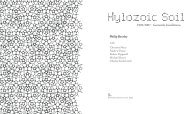The Inner Studio - Riverside Architectural Press
The Inner Studio - Riverside Architectural Press
The Inner Studio - Riverside Architectural Press
You also want an ePaper? Increase the reach of your titles
YUMPU automatically turns print PDFs into web optimized ePapers that Google loves.
PART FOUR | INNER KNOW-HOW<br />
First Stage: Preliminary Design<br />
It makes the most sense to invite a critique of a project after the<br />
creative direction and basic design language have been established.<br />
<strong>The</strong> question that needs to be answered is, “Does the proposition<br />
stand up to local or global review? Is there a convincing demonstration<br />
of the benefits of the proposition?” Is the big idea capable<br />
of carrying the project into the world?<br />
If you are prone to severe self-criticism and impatience, then<br />
you may find you are unable to internally grow an idea to its richest<br />
outcome. You may need to get to know your critical voice and<br />
consciously recognize it when it possesses you so that you can shift<br />
to the part of you that believes the project is worthwhile and<br />
worthy of being successfully completed. This doesn’t mean that you<br />
should allow your ideas to go untested. But initial testing must<br />
always have the intention not of attacking the work, but helping to<br />
search for the truth of the founding idea in the project. If a critique<br />
is constructive, it addresses the substance of the idea. As the idea<br />
becomes more and more substantial, the proposition will naturally<br />
need more rigorous testing.<br />
Designers are always searching for certainty, something that, in<br />
the cycle of design, is constantly shifting. Our bodies, dreams, and<br />
shadow are always available to us to deepen our sense of knowing<br />
the true course of our work. <strong>The</strong> reason that we need to bring an<br />
awareness of these phases to the creative process is that there is a<br />
real danger of activating critical states that will destroy creative<br />
impulses. And, as we have seen, the compounded result of these<br />
acts is that, eventually, the artifacts and places of the built world<br />
transmit these negative messages. For the designer, once the<br />
creative impulse is muted or deadened, it may be very difficult to<br />
bring its rich voice back to our task.<br />
141





